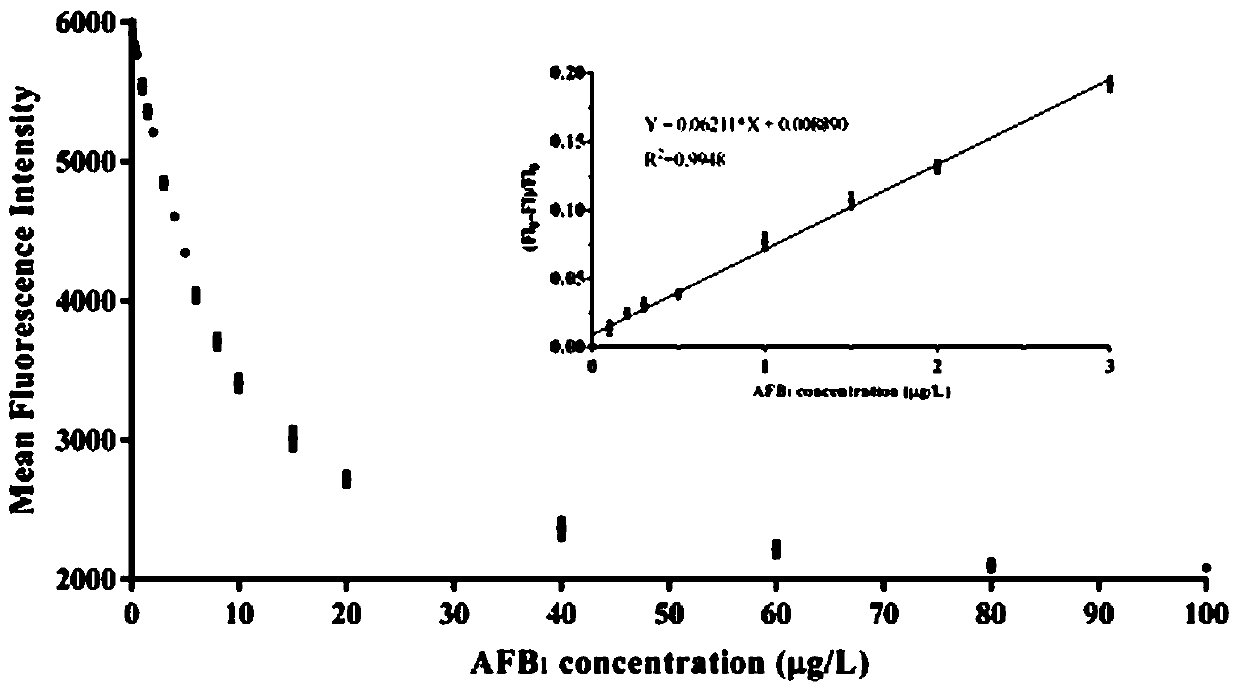Method for determining aflatoxin B1 based on immunomagnetic beads
A technology of aflatoxin and immunomagnetic beads, which is applied in the direction of measuring devices, instruments, scientific instruments, etc., and can solve the problems that the quantitative determination of mycotoxins by immunomagnetic beads and flow cytometry has not been reported.
- Summary
- Abstract
- Description
- Claims
- Application Information
AI Technical Summary
Problems solved by technology
Method used
Image
Examples
Embodiment 1
[0062] Precisely pipette 1mg of 0.5μm carboxyl magnetic beads into a 1.5mL centrifuge tube, then wash 3 times with 0.1M MES buffer (pH6.2), then perform magnetic separation, and resuspend the carboxyl magnetic beads after magnetic separation in PBS buffer to prepare magnetic bead suspension. Add 0.77mg EDC and 1.09mgsulfo-NHS to the carboxyl magnetic bead suspension and incubate for 20 minutes at 25°C on a Limber BE-1100 mixer to activate the carboxyl groups on the surface of the magnetic beads, and centrifuge to obtain activated carboxyl groups magnetic beads. Then, resuspend the above-mentioned activated carboxyl magnetic beads in 0.5ml PBS buffer (containing 100μl AFB 1 -BSA) and shake gently on its Limbell BE-1100 mixer for 1 h to form AFB at 25 °C 1 -BSA-MBs solution. After magnetic separation, the AFB 1 -BSA-MBs were stored in 10ml PBS buffer containing 0.05% Tween-20 and 1% BSA, AFB 1 -BSA-MBs preservation solution was diluted to 1 / 100 with PBS buffer to obtain AFB...
Embodiment 2
[0064]Precisely pipette 1mg of 0.5μm carboxyl magnetic beads into a 1.5mL centrifuge tube, then wash 3 times with 0.1M MES buffer (pH6.2), then perform magnetic separation, and resuspend the carboxyl magnetic beads after magnetic separation in PBS buffer to prepare magnetic bead suspension. Add 0.77mg EDC and 1.09mgsulfo-NHS to the carboxyl magnetic bead suspension and incubate for 20 minutes at room temperature (25°C) on its Limber BE-1100 mixer to activate the carboxyl groups on the surface of the magnetic beads, centrifuge, Get activated carboxyl magnetic beads. Then, resuspend the above-mentioned activated carboxyl magnetic beads in 0.5ml PBS buffer (pH7.4, containing 100μL AFB 1 -BSA) and shake gently for 1 h on its Limbell BE-1100 mixer to form AFB at room temperature (25°C). 1 -BSA-MBs solution. After magnetic separation, the AFB 1 -BSA-MBs were stored in 10ml PBS buffer containing 0.05% Tween-20 and 1% BSA, AFB 1 -BSA-MBs preservation solution was diluted to 1 / 100...
Embodiment 3
[0066] Precisely pipette 1mg of 0.5μm carboxyl magnetic beads into a 1.5mL centrifuge tube, then wash 3 times with 0.1MMES buffer (pH6.2), then perform magnetic separation, and resuspend the carboxyl magnetic beads after magnetic separation in PBS buffer In , the magnetic bead suspension was prepared. Add 0.77 mg EDC and 1.09 mg sulfo-NHS to the carboxyl magnetic bead suspension and incubate for 20 minutes at room temperature (25°C) on its Limber BE-1100 mixer to activate the carboxyl groups on the surface of the magnetic beads, centrifuge, Get activated carboxyl magnetic beads. Then, resuspend the above-mentioned activated carboxyl magnetic beads in 0.5ml PBS buffer (pH7.4, containing 100μL AFB 1 -BSA) and shake gently for 1 h on its Limbell BE-1100 mixer to form AFB at room temperature (25°C). 1 -BSA-MBs solution. After magnetic separation, the AFB 1 -BSA-MBs were stored in 10ml PBS buffer containing 0.05% Tween-20 and 1% BSA, AFB 1 -BSA-MBs preservation solution was di...
PUM
 Login to View More
Login to View More Abstract
Description
Claims
Application Information
 Login to View More
Login to View More - R&D
- Intellectual Property
- Life Sciences
- Materials
- Tech Scout
- Unparalleled Data Quality
- Higher Quality Content
- 60% Fewer Hallucinations
Browse by: Latest US Patents, China's latest patents, Technical Efficacy Thesaurus, Application Domain, Technology Topic, Popular Technical Reports.
© 2025 PatSnap. All rights reserved.Legal|Privacy policy|Modern Slavery Act Transparency Statement|Sitemap|About US| Contact US: help@patsnap.com

